ENERGY FEATURES
One of the main challenges of the project is the design of a zero energy building ( Z.E.B.). This goal has been achieved by means of the optimisation and the integration of three items:
- the building shape and envelope have been designed keeping into account all the bioclimatic architecture principles;
- the active systems typologies and components are as high as possible energy efficient; furthermore all the energy needs are satisfied by alternative and renewable sources;
- the energy management is based on an advanced control system that allows the optimisation of the working conditions of the plants and that avoids misuses
- ARCHITECTURAL SHAPE AND ENVELOPE ENERGY PERFORMANCES
The solar greenhouse on the southern front, the solar chimney of the glazed lobby, the terraces on the western facade are some examples of how the architectural shape can achieve solar gains during the cold season and can avoid overheatings during the hot one.
Another important step is to avoid heat losses and thermal bridges. In this case the performances of the building materials in particular those of the envelope structure (walls and windows ), play an important role that depends on their thermal insulation capacity.
Therefore extremely low U – values are foreseen.
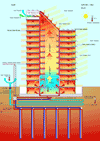  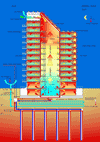 |
|
Winter season |
|
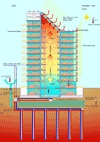  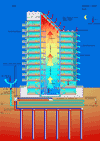 |
| Summer season |
- ACTIVE SYSTEMS AND RENEWABLE ENERGY
The active systems should mainly provide control of temperature, air quality and humidity (i.e. climatisation) and lighting. Furthermore they should provide sanitary hot water and electricity for appliances, PCs, etc.
As far as climatisation is concerned, a ground heat pump is foreseen coupled with radiant panels, both for heating and cooling, and mechanical ventilation with heat recovery. The system require electrical energy, therefore a PV system is foreseen.
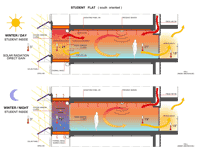 |
|
Winter season |
|
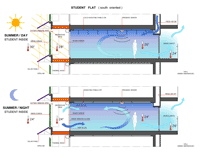 |
| Summer season |
Furthermore, heating and hot water production can be coupled with a thermal solar system. Both can be easily integrated on the sloping glazed roof of the lobby, on a large extent of the surface of the southern front and over the flat roof of the two rectangular buildings. Also for lighting the system efficiency has been optimised. First of all, the rooms are naturally lighted as long as possible by optimisation of the architecture. Second, low energy lamps are foreseen and a control system integrates both natural and artificial lighting.
Finally, the electricity needs for appliances and other uses can be met by the PV system, as far as possible<
- ENERGY MONITORING and MANAGEMENT
The building is equipped with a Building Management System (BMS), i.e. a computer based control system that controls and monitors the building’s mechanical and electrical equipment such as air handling and cooling plant systems, lighting, power systems, fire systems, and security systems. The BMS allows the optimisation of the systems in order to achieve the best comfort conditions with the minimum energy consumptions.
For example, the ventilation rates are managed by means of a CO2 concentration control system, the lighting is automatically switched off when nobody stay within a room, the heating and cooling storages are managed for best use of thermal energy coming from the solar system and of the thermal flow that can be exchanged with the ground, etc.
|
|
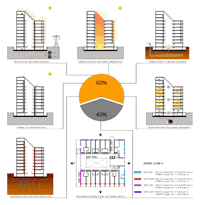 |
ENERGY PERFORMANCE OF THE BUILDING
Some detailed simulations have already been run by “Energy Plus” simulation model, i.e. the model developed by the U.S. Department of Energy that is one of the most advanced tools available at world level. The results show that all the energy needs for heating, cooling, ventilation, hot water production and lighting can be satisfied by the renewable energy systems integrated on the building. This advanced result is due to the minimisation of the energy needs coupled with the solar and geothermal systems adopted. Probably even the most part of the electrical demands for appliances, PCs etc could be met by the PV system: these energy consumptions usually are not kept into account when defining “zero energy building”, therefore the project could be almost “actually zero energy building”, i.e. even better than what usually is considered “zero energy building”.
|






